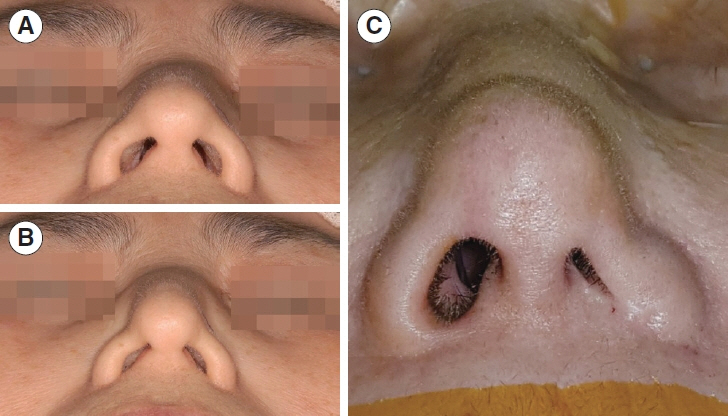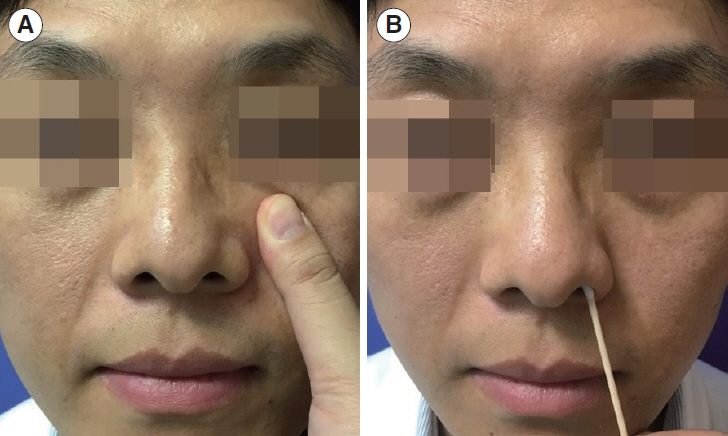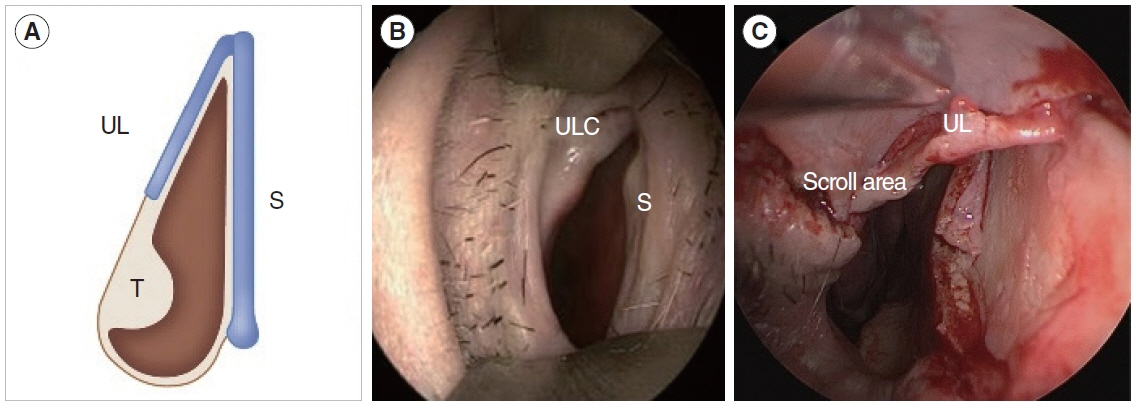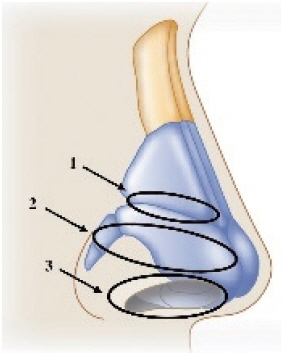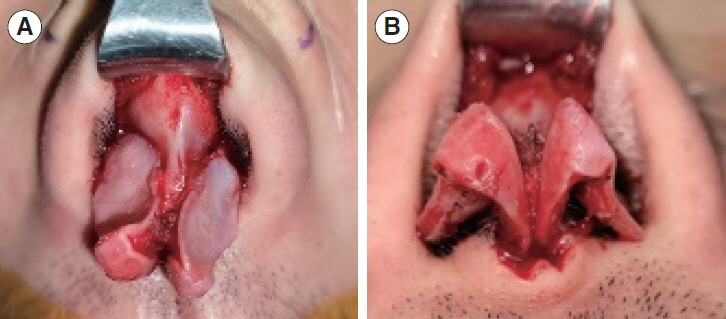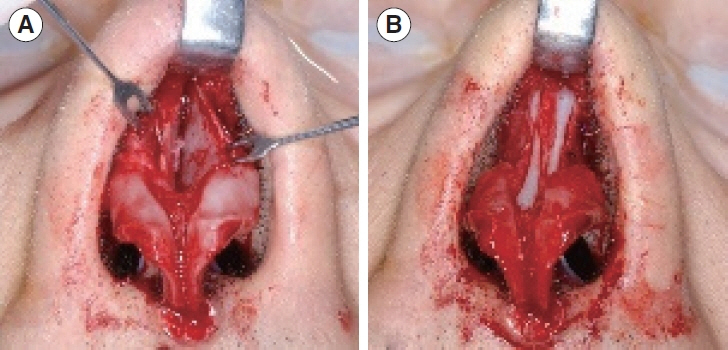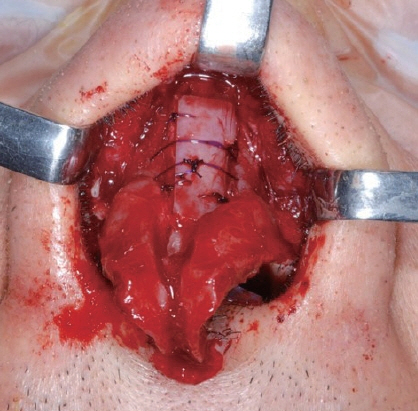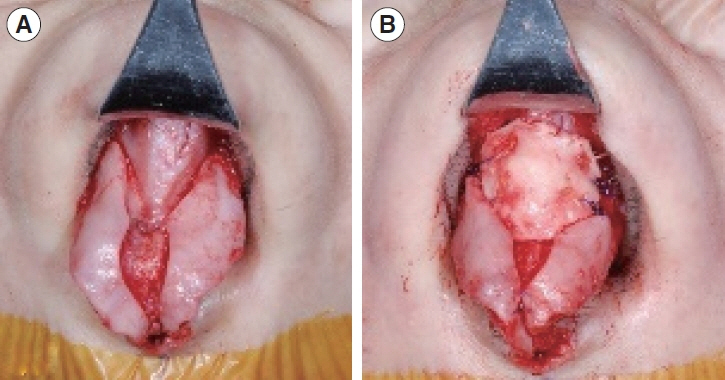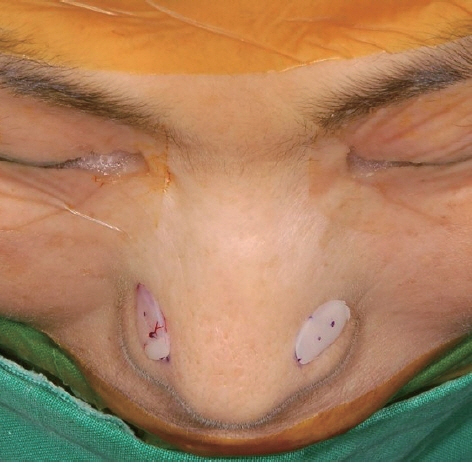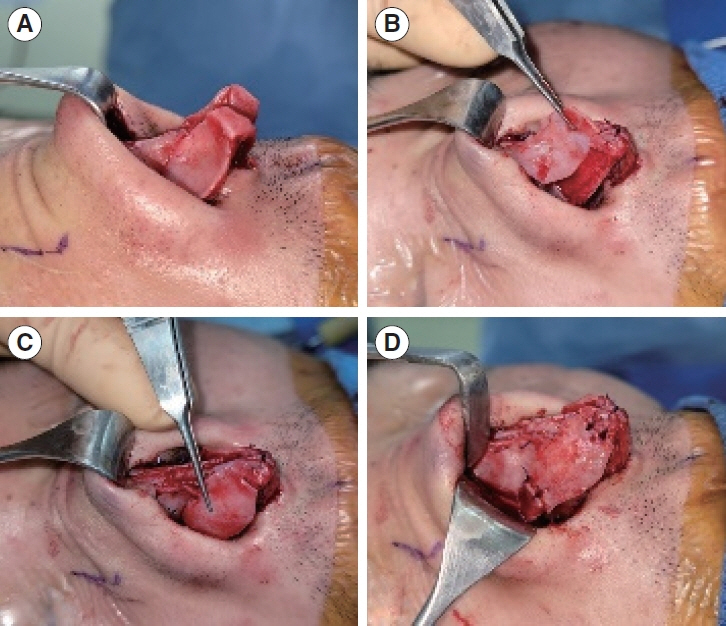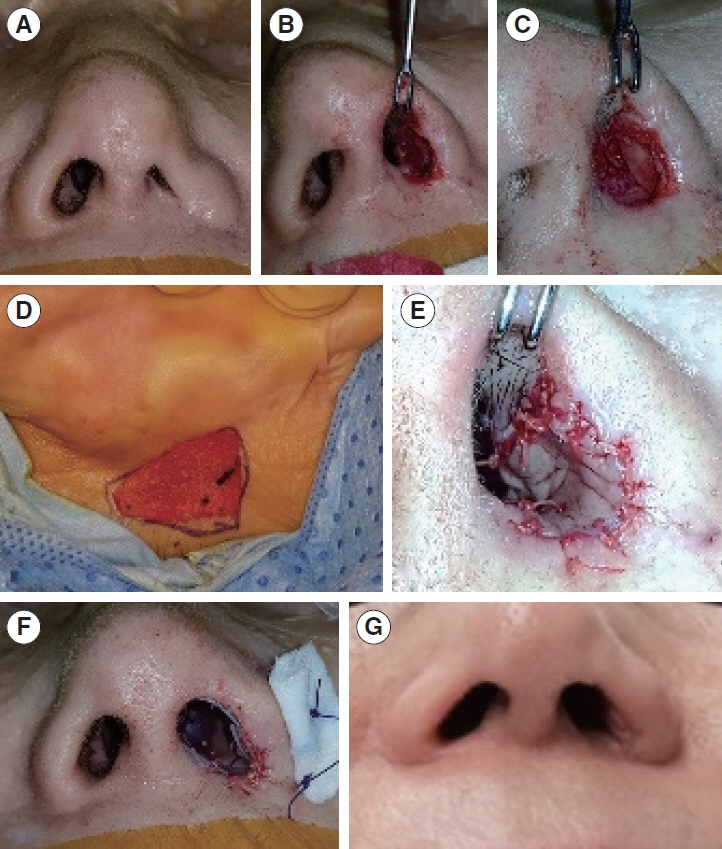Clin Exp Otorhinolaryngol.
2024 Aug;17(3):189-197. 10.21053/ceo.2024.00073.
Management of Nasal Valve Dysfunction
- Affiliations
-
- 1Department of Otorhinolaryngology-Head and Neck Surgery, Soonchunhyang University College of Medicine, Seoul, Korea
- 2Department of Otorhinolaryngology-Head and Neck Surgery, Seoul National University Hospital, Seoul, Korea
- KMID: 2558835
- DOI: http://doi.org/10.21053/ceo.2024.00073
Abstract
- Nasal valve dysfunction can substantially impact nasal airflow and overall quality of life. This review provides a comprehensive examination of nasal valve dysfunction, including its mechanisms, classification, and surgical management. The nasal valves include internal and external valves, each of which plays a crucial role in regulating nasal airflow. Subclassification of the external nasal valve into alar and rim valves helps specify the site of obstruction when present and informs the choice of surgical intervention. Dynamic nasal valve obstruction, often characterized by inspiratory collapse of the nasal valve, must be distinguished from static obstruction, which refers to nasal valve stenosis. Accurate identification of the location and mechanism of nasal valve dysfunction is essential for effective management. Various surgical procedures target specific components of the nasal valve and can produce favorable functional outcomes. The selection of surgical procedures, whether individually or in combination, should be tailored to the characteristics of nasal valve dysfunction and the external nasal characteristics of the patient. Strict adherence to proper surgical techniques is imperative for achieving optimal treatment outcomes.
Figure
Reference
-
1. Kim BK, Heo Y, Park SI, Hong SD, Jung YG, Kim HY. One-unit osteotomy to correct deviated bony dorsum. Clin Exp Otorhinolaryngol. 2023; Feb. 16(1):59–66.2. Mella J, Oyer S, Park S. Functional rhinoplasty: what really works. Laryngoscope. 2023; May. 133(5):1002–4.3. Mink PJ. Le nez comme voie respiratoire. Presse Otolaryngol Belg. 1903; 21:481–96.4. Nigro CE, Nigro JF, Mion O, Mello JF Jr. Nasal valve: anatomy and physiology. Braz J Otorhinolaryngol. 2009; Mar-Apr. 75(2):305–10.5. Bloching MB. Disorders of the nasal valve area. GMS Curr Top Otorhinolaryngol Head Neck Surg. 2007; 6:Doc07.6. Garcia GJ, Hariri BM, Patel RG, Rhee JS. The relationship between nasal resistance to airflow and the airspace minimal cross-sectional area. J Biomech. 2016; Jun. 49(9):1670–8.7. Cole P. The four components of the nasal valve. Am J Rhinol. 2003; Mar-Apr. 17(2):107–10.8. Hsu DW, Suh JD. Anatomy and physiology of nasal obstruction. Otolaryngol Clin North Am. 2018; Oct. 51(5):853–65.9. Sulsenti G, Palma P. The nasal valve area: structure, function, clinical aspects and treatment. Sulsenti’s technic for correction of valve deformities. Acta Otorhinolaryngol Ital. 1989; 9 Suppl 22:1–25.10. Suh MW, Jin HR, Kim JH. Computed tomography versus nasal endoscopy for the measurement of the internal nasal valve angle in Asians. Acta Otolaryngol. 2008; Jun. 128(6):675–9.11. Hamilton GS 3rd. The external nasal valve. Facial Plast Surg Clin North Am. 2017; May. 25(2):179–94.12. Jin HR, Won TB. Nasal hump removal in Asians. Acta Otolaryngol Suppl. 2007; Oct. (558):95–101.13. Jin HR, Won TB. Rhinoplasty in the Asian patient. Clin Plast Surg. 2016; Jan. 43(1):265–79.14. Won TB. Hump nose correction in Asians. Facial Plast Surg Clin North Am. 2018; Aug. 26(3):357–66.15. Go BC, Frost A, Friedman O. Addressing the nasal valves: the endonasal approach. Facial Plast Surg. 2022; Feb. 38(1):57–65.16. Spielmann PM, White PS, Hussain SS. Surgical techniques for the treatment of nasal valve collapse: a systematic review. Laryngoscope. 2009; Jul. 119(7):1281–90.17. Stewart MG, Witsell DL, Smith TL, Weaver EM, Yueh B, Hannley MT. Development and validation of the Nasal Obstruction Symptom Evaluation (NOSE) scale. Otolaryngol Head Neck Surg. 2004; Feb. 130(2):157–63.18. Rhee JS, Poetker DM, Smith TL, Bustillo A, Burzynski M, Davis RE. Nasal valve surgery improves disease-specific quality of life. Laryngoscope. 2005; Mar. 115(3):437–40.19. Rhee JS, Arganbright JM, McMullin BT, Hannley M. Evidence supporting functional rhinoplasty or nasal valve repair: a 25-year systematic review. Otolaryngol Head Neck Surg. 2008; Jul. 139(1):10–20.20. Tsounis M, Swart KM, Georgalas C, Markou K, Menger DJ. The clinical value of peak nasal inspiratory flow, peak oral inspiratory flow, and the nasal patency index. Laryngoscope. 2014; Dec. 124(12):2665–9.21. Menger DJ, Swart KM, Nolst Trenite GJ, Georgalas C, Grolman W. Surgery of the external nasal valve: the correlation between subjective and objective measurements. Clin Otolaryngol. 2014; Jun. 39(3):150–5.22. Teller DC. Anatomy of a rhinoplasty: emphasis on the middle third of the nose. Facial Plast Surg. 1997; Oct. 13(4):241–52.23. Saban Y, Andretto Amodeo C, Hammou JC, Polselli R. An anatomical study of the nasal superficial musculoaponeurotic system: surgical applications in rhinoplasty. Arch Facial Plast Surg. 2008; Mar-Apr. 10(2):109–15.24. Tardy ME, Brown RJ. Topographic anatomy and landmarks. In: Tardy ME, Brown RJ, editors. Surgical anatomy of the nose. Raven Press; 1990.25. Howard BK, Rohrich RJ. Understanding the nasal airway: principles and practice. Plast Reconstr Surg. 2002; Mar. 109(3):1128–46.26. Lam SM, Williams EF 3rd. Anatomic considerations in aesthetic rhinoplasty. Facial Plast Surg. 2002; Nov. 18(4):209–14.27. Won TB, Kang JG, Jin HR. Management of post-traumatic combined deviated and saddle nose deformity. Acta Otolaryngol. 2012; Jun. 132 Suppl 1:S44–51.28. Jang YJ. Can we kill two birds with one stone?: achieving function and aesthetics by extracorporeal septoplasty. Clin Exp Otorhinolaryngol. 2021; Feb. 14(1):9–10.29. Mun SJ, Choi YS, Kim JH, Shim WS, Jung HJ. Evaluation of the esthetic and functional outcomes of extracorporeal septoplasty for rhinoplasty in Asian patients. Clin Exp Otorhinolaryngol. 2021; Feb. 14(1):100–7.30. Sheen JH. Spreader graft: a method of reconstructing the roof of the middle nasal vault following rhinoplasty. Plast Reconstr Surg. 1984; Feb. 73(2):230–9.31. Kim L, Papel ID. Spreader grafts in functional rhinoplasty. Facial Plast Surg. 2016; Feb. 32(1):29–35.32. Nyte CP. Hyaluronic acid spreader-graft injection for internal nasal valve collapse. Ear Nose Throat J. 2007; May. 86(5):272–3.33. Reiffel AJ, Cross KJ, Spinelli HM. Nasal spreader grafts: a comparison of medpor to autologous tissue reconstruction. Ann Plast Surg. 2011; Jan. 66(1):24–8.34. Erickson B, Hurowitz R, Jeffery C, Ansari K, El Hakim H, Wright ED, et al. Acoustic rhinometry and video endoscopic scoring to evaluate postoperative outcomes in endonasal spreader graft surgery with septoplasty and turbinoplasty for nasal valve collapse. J Otolaryngol Head Neck Surg. 2016; Jan. 45:2.35. Jalali MM. Comparison of effects of spreader grafts and flaring sutures on nasal airway resistance in rhinoplasty. Eur Arch Otorhinolaryngol. 2015; Sep. 272(9):2299–303.36. Byrd HS, Meade RA, Gonyon DL Jr. Using the autospreader flap in primary rhinoplasty. Plast Reconstr Surg. 2007; May. 119(6):1897–902.37. Sinkler MA, Wehrle CJ, Elphingstone JW, Magidson E, Ritter EF, Brown JJ. Surgical management of the internal nasal valve: a review of surgical approaches. Aesthetic Plast Surg. 2021; Jun. 45(3):1127–36.38. Barrett DM, Casanueva FJ, Cook TA. Management of the nasal valve. Facial Plast Surg Clin North Am. 2016; Aug. 24(3):219–34.39. Saedi B, Amali A, Gharavis V, Yekta BG, Most SP. Spreader flaps do not change early functional outcomes in reduction rhinoplasty: a randomized control trial. Am J Rhinol Allergy. 2014; Jan-Feb. 28(1):70–4.40. Choi IJ, Kim KH, Kim NY, Lee MC. Diagnosis and treatment of dynamic external nasal valve collapse: application of alar batten graft and alar f laring suture. Korean J Otorhinolaryngol-Head Neck Surg. 2016; Jul. 59(7):551–6.41. Jin HR, Kim SJ. Presentation patterns and surgical management of the complications of thread rhinoplasty. Clin Exp Otorhinolaryngol. 2022; Aug. 15(3):247–53.42. Hage J. Collapsed alae strengthened by conchal cartilage (the butterfly cartilage graft). Br J Plast Surg. 1965; Jan. 18:92–6.43. Friedman O, Coblens O. The conchal cartilage butterfly graft. Facial Plast Surg. 2016; Feb. 32(1):42–8.44. Clark JM, Cook TA. The ‘butterfly’ graft in functional secondary rhinoplasty. Laryngoscope. 2002; Nov. 112(11):1917–25.45. Howard BE, Madison Clark J. Evolution of the butterfly graft technique: 15-year review of 500 cases with expanding indications. Laryngoscope. 2019; Apr. 129(S1):S1–10.46. Kim DY, Kim IS, Jin HR. Frequently used grafts in Korean rhinoplasty: nomenclature and definitions. Korean J Otorhinolaryngol-Head Neck Surg. 2010; Jul. 53(7):412–8.47. Sufyan A, Ziebarth M, Crousore N, Berguson T, Kokoska MS. Nasal batten grafts: are patients satisfied. Arch Facial Plast Surg. 2012; JanFeb. 14(1):14–9.48. Bewick JC, Buchanan MA, Frosh AC. Internal nasal valve incompetence is effectively treated using batten graft functional rhinoplasty. Int J Otolaryngol. 2013; 2013:734795.49. Ballert JA, Park SS. Functional rhinoplasty: treatment of the dysfunctional nasal sidewall. Facial Plast Surg. 2006; Feb. 22(1):49–54.50. Fanous N. Columelloplasty for the wide obstructing columella. Laryngoscope. 1990; Feb. 100(2 Pt 1):203–5.51. Totonchi A, Guyuron B. Alar rim deformities. Clin Plast Surg. 2016; Jan. 43(1):127–34.52. Deroee AF, Younes AA, Friedman O. External nasal valve collapse repair: the limited alar-facial stab approach. Laryngoscope. 2011; Mar. 121(3):474–9.53. Boahene KD, Hilger PA. Alar rim grafting in rhinoplasty: indications, technique, and outcomes. Arch Facial Plast Surg. 2009; Sep-Oct. 11(5):285–9.54. Gruber RP, Fox P, Peled A, Belek KA. Grafting the alar rim: application as anatomical graft. Plast Reconstr Surg. 2014; Dec. 134(6):880e–887e.55. Klinger M, Maione L, Villani F, Caviggioli F, Forcellini D, Klinger F. Reconstruction of a full-thickness alar wound using an auricular conchal composite graft. Can J Plast Surg. 2010; Winter. 18(4):149–51.56. Daya M. Nostril stenosis corrected by release and serial stenting. J Plast Reconstr Aesthet Surg. 2009; Aug. 62(8):1012–9.57. Riley CA, Lawlor CM, Gray ML, Graham HD 3rd. Free auricular composite graft for acquired nasal stenosis. Ochsner J. 2016; Summer. 16(2):150–3.
- Full Text Links
- Actions
-
Cited
- CITED
-
- Close
- Share
- Similar articles
-
- Definition of Nasal Valve Location and Classification of Nasal Valve Stenosis in Computed Tomography
- Measurement of the so-called "Nasal Valve" in Japanese Subjects
- Treatment of the Nasal Valve Stenosis
- Surgical Correction of Dynamic Nasal Valve Collapse
- How to Adjust the Thickness of the Spreader Graft in Nasal Valve Collapse

